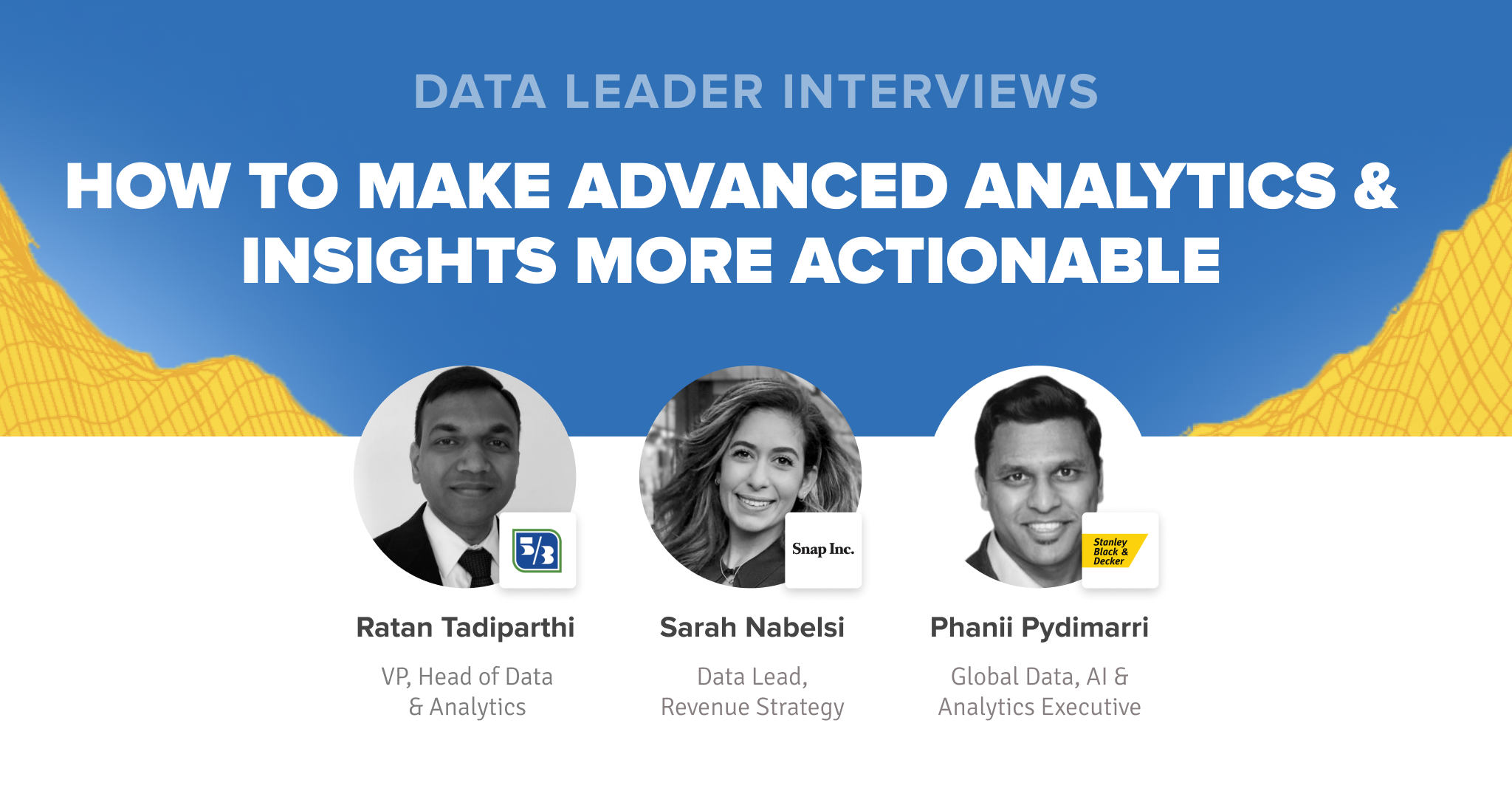March 5, 2019
What’s the best BI tool for Hadoop?
I hosted another round of interviews last week with data leaders about generating actionable insights and improving data analytics. We discussed the importance of building a data-driven culture, measuring the success of data analytics initiatives, and how to overcome the challenges of delivering data solutions to business users.
The data experts I spoke to included: Ratan Tadiparthi, Head of Data and Analytics at Fifth Third Bank; Phanii Pydimarri, Global Data, AI and Analytics Executive at Stanley Black and Decker; and Sarah Nabelsi, Data Lead at Snap, Inc.
Here are some of the most interesting insights from these data industry veterans.
How does culture impact the success of advanced data analytics programs?
According to Ratan Tadiparthi of Fifth Third Bank, culture is how we get things done. While everything starts with a data strategy – which ultimately produces value – execution is the key to success. “You might have heard the phrase ‘culture eats strategy for breakfast’,” Tadiparthi suggested, “but I might even say ‘execution eats culture for lunch’.” The true test of a team’s culture is actually executing on a strategy and measuring the results.
As technologies evolve and the technology limitations for data analytics fall, the primary challenge to becoming data-driven is a successful shifting in culture. That’s why Tadiparthi’s team at Fifth Third Bank has organized their analytics program into a pyramid approach. Actionable insights is at the top of the pyramid, supported by high-level business priorities, specific operational targets, low-level tactical focuses, and business domain-driven goals.
This entire data-driven value chain rests on a strong foundation of technologies, processes, and most importantly, the people and organizational structure. It’s crucial for everyone at Fifth Third Bank to view data as a key part of their job – and not a barrier. “Everyone’s job is data,” Tadiparthi concluded, “because everyone essentially produces or consumes data.”
What is the best way to measure whether an analytics initiative was worth it?
Phanii Pydimarri of Stanley Black and Decker said it’s challenging to measure the success of data analytics initiatives because not everything is quantifiable. That said, he believes it’s important to attribute a dollar amount to a data initiative, whether it’s incremental revenue or cost avoidance.
“That’s an easy win if you’re able to measure a data initiative as a quantifiable revenue impact,” Pydimarri explained. “But there are a lot of qualitative improvements that data analytics can bring, which is the tricky part.” For example, improvements to customer adoption or engagement can be difficult to tie back to a specific data initiative without carefully considering relevant metrics.
For this reason, he suggests choosing a parent metric – whether it’s revenue, customer satisfaction, product quality, or another business KPI – and then identify multiple metrics that might contribute to that higher-level metric.
“It really comes down to how well you’re able to understand your metrics from a low-level standpoint, and how you’re able to view them as quantifiable metrics,” Pydimarri concluded.
What’s the most difficult aspect of data projects?
Sarah Nabelsi of Snap, Inc. believes that most data projects consist of three major aspects: domain, data, and deliverable. “Each one of these presents a different challenge,” she said. “But the hardest one to nail down might be the deliverable.”
Delivering a data project can be challenging because data teams may not have easy access to their stakeholders and these stakeholders may not know exactly what they want. “Even if you have access to stakeholders, we’re still prone to miscommunication,” Nabelsi added. To avoid a disconnect with stakeholders, she believes it’s important to ask questions and build data solutions iteratively so that data teams can deliver a solution that’s closely aligned with stakeholder needs.
In the end, generating effective insights from data requires engagement from the entire business. A strong data-driven culture is crucial for executing a data analytics strategy, while establishing quantifiable business goals is important for measuring whether the strategy succeeded. Finally, effective communication between data teams and business stakeholders is essential for delivering data solutions that drive the business forward.
You can watch the full discussion I had with these data leaders about How to Make Advanced Analytics & Insights More Actionable. In addition, we put together an eBook about how to Make AI & BI Work at Scale with 15 thought leaders and experts in the data industry about scaling AI and BI at large organizations.


NEW BOOK